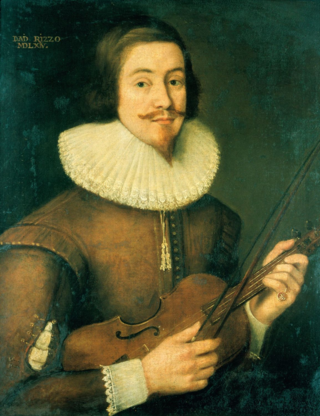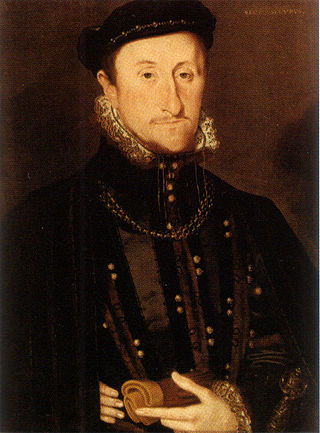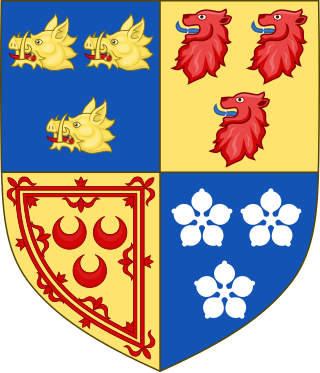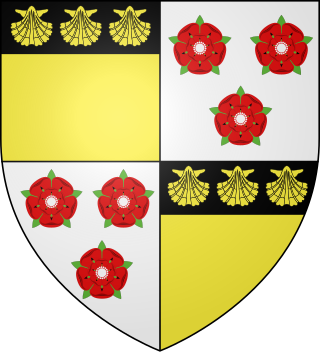Related Research Articles

James V was King of Scotland from 9 September 1513 until his death in 1542. He was crowned on 21 September 1513 at the age of seventeen months. James was the son of King James IV and Margaret Tudor, daughter of Henry VII of England. During his childhood Scotland was governed by regents, firstly by his mother until she remarried, and then by his first cousin once removed, John Stewart, Duke of Albany. James's personal rule began in 1528 when he finally escaped the custody of his stepfather, Archibald Douglas, 6th Earl of Angus. His first action was to exile Angus and confiscate the lands of the Douglases.

David Rizzio or Riccio was an Italian courtier, born in Pancalieri close to Turin, a descendant of an ancient and noble family still living in Piedmont, the Riccio Counts di San Paolo e Solbrito, who rose to become the private secretary of Mary, Queen of Scots. Mary's husband, Lord Darnley, is said to have been jealous of their friendship because of rumours that Rizzio had impregnated Mary, and he joined in a conspiracy of Protestant nobles to murder him, led by Patrick Ruthven, 3rd Lord Ruthven. Mary was having dinner with Rizzio and a few ladies-in-waiting when Darnley joined them, accused his wife of adultery and then had a group murder Rizzio, who was hiding behind Mary. Mary was held at gunpoint and Rizzio was stabbed numerous times. His body took 57 dagger wounds. The murder was the catalyst of the downfall of Darnley, and had serious consequences for Mary's subsequent reign.

Cambuskenneth Abbey is an Augustinian monastery located on an area of land enclosed by a meander of the River Forth near Stirling in Scotland. The abbey today is largely reduced to its foundations, however its bell tower remains. The neighbouring modern village of Cambuskenneth is named after it.

James Stewart, 1st Earl of Moray was a member of the House of Stewart as the illegitimate son of King James V of Scotland. At times a supporter of his half-sister Mary, Queen of Scots, he was the regent of Scotland for his half-nephew, the infant King James VI, from 1567 until his assassination in 1570. He was the first head of government to be assassinated with a firearm.
James Stewart, Earl of Moray was a Scottish nobleman and diplomat.
The Lord Chancellor of Scotland, formally titled Lord High Chancellor, was an Officer of State in the Kingdom of Scotland. The Lord Chancellor was the principal Great Officer of State, the presiding officer of the Parliament of Scotland, the Keeper of the Great Seal, the presiding officer of the Privy Council, and a judge of the College of Justice.

James Hamilton, 1st Earl of Arran and 2nd Lord Hamilton was a Scottish nobleman, naval commander and first cousin of James IV of Scotland. He also served as the 9th Lord High Admiral of Scotland.

Andrew Forman was a Scottish diplomat and prelate who became Bishop of Moray in 1501, Archbishop of Bourges in France, in 1513, Archbishop of St Andrews in 1514 as well as being Commendator of several monasteries.

Alexander Stewart was an illegitimate son of King James IV of Scotland by his mistress Marion Boyd. He was the King's eldest illegitimate child. He was an elder brother of Catherine Stewart, his only full sibling, and was an older half-brother of the future James V. He was installed as Archbishop of St Andrews at the age of eleven and was killed beside his father the King at the Battle of Flodden aged twenty.

Alexander Seton, 1st Earl of Huntly, who adopted the family name of Gordon from about 1457, was a powerful 15th-century Scottish magnate. He was knighted in 1439/1440 and was Lord of Badenoch, Gordon, Strathbogie and Cluny.
John Erskine, 5th Lord Erskine was a Scottish nobleman.
David Panter, Scottish diplomat, clerk and bishop of Ross, was the illegitimate son of Patrick Paniter, secretary to James IV; his mother was Margaret Crichton, illegitimate daughter of William Crichton, 3rd Lord Crichton and widow countess of Rothes.
Malcolm Fleming, 3rd Lord Fleming, was Lord Chamberlain of Scotland to King James V, from 1524.

William Graham, 1st Earl of Montrose was a Scottish Lord of Parliament, who was raised to an earldom by James IV of Scotland and who died with his monarch at the Battle of Flodden.

Mary of Bourbon or Marie de Bourbon was a daughter of Charles, Duke of Vendôme, and Françoise d'Alençon, daughter of René, Duke of Alençon. Mary was the subject of marriage negotiations of James V of Scotland. He visited her in France, but subsequently married Madeleine of Valois. Mary died two years later.
Robert Barton of Over Barnton was a Scottish landowner, merchant, sailor and politician. He served as Comptroller, Master of the Mint and Lord High Treasurer to James V of Scotland.
William Lamb, or William Paniter alias Lamb, was a Scottish cleric, lawyer, and author.
Alexander Home, 3rd Lord Home was a Scottish soldier and nobleman, Chamberlain of Scotland and Warden of the Eastern March. He fought at the Battle of Flodden where his forces defeated the English right wing before the Scottish army was destroyed. After the battle, he resisted the regency of John Stewart, Duke of Albany and was captured and executed for rebellion.

The Marian civil war in Scotland (1568–1573) was a period of conflict which followed the abdication of Mary, Queen of Scots, and her escape from Lochleven Castle in May 1568. Those who ruled in the name of her infant son James VI fought against the supporters of the Queen, who was exiled in England. Edinburgh Castle, which was garrisoned in her name, became the focus of the conflict and surrendered only after an English intervention in May 1573. The conflict in 1570 was called an "internecine war in the bowels of this commonwealth", and the period was called soon after an "internecine war driven by questions against authority."

John Mowbray of Barnbougle was a Scottish landowner and supporter of Mary, Queen of Scots.
References
- ↑ Hay, Denys ed., Letters of James V (HMSO, 1954), p. 17.
- ↑ Hay, Denys ed., Letters of James V (HMSO, 1954), pp. 58-59.
- ↑ Mackie & Spilman ed., The Letters of James IV (Edinburgh, 1953), pp. xxxviii-xxxiv, no. 360.
- ↑ Accounts of the Lord High Treasurer, vol. 10 (Edinburgh, 1913), p. lxxx.
- ↑ Proceedings of the Society of Antiquaries Scotland, vol. 73, p. 325.